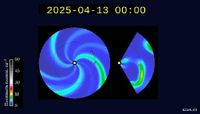On April 13, 2025, scientists reported that two powerful solar protuberances were emitted from the Sun towards Earth. This solar matter is expected to reach our planet on the night of April 15 to April 16, 2025, with the most probable time being around 22:00 Moscow time. As the solar material approaches, geomagnetic disturbances are anticipated to last nearly a day on April 16, with the second half of the day expected to be a peak period for second-level storms.
The peak impact of these disturbances is predicted to occur in the latter half of Tuesday, April 15, after 21:00. According to forecasts, magnetic storms classified as G1-G2 are likely. The duration of these geomagnetic disturbances could extend for almost a full day, as scientists confirm the separation and trajectory of the protuberances towards Earth.
These solar protuberances are massive structures formed in the solar atmosphere, composed of dense gas and can measure several hundred thousand kilometers in size. They are held aloft in the Sun's corona by magnetic field lines, similar to how clouds are suspended in Earth's atmosphere. Due to their long lifespan and high gas density, the mass of these protuberances can be extraordinarily large, comparable to the mass of the entire solar corona.
As the solar storms approach, experts warn of potential impacts on technology and human health. Geomagnetic storms can disrupt satellite operations, interfere with electronic devices on Earth, and even affect human physiology. While the exact effects on human health remain unclear, many individuals report feeling unwell during periods of geomagnetic storms.
In previous reports, it has been noted that the intensity of these storms can vary throughout the month of April, with different levels of intensity expected at the beginning, middle, and end of the month. For instance, just days ago, Ukraine experienced a significant magnetic storm, highlighting the storms' potential to affect daily life.
As the solar matter travels through space, its interaction with Earth's magnetic field can lead to various phenomena, including auroras and disruptions in communication systems. The upcoming magnetic storms are a reminder of the powerful forces at play in our solar system and their ability to impact life on Earth.
In summary, the solar activity observed on April 13 has set the stage for a series of geomagnetic disturbances expected to peak on April 16. With the potential for G1-G2 magnetic storms and a 70% probability of further storm formation in the coming days, it is crucial for individuals and organizations to prepare for the possible effects of these solar events.







